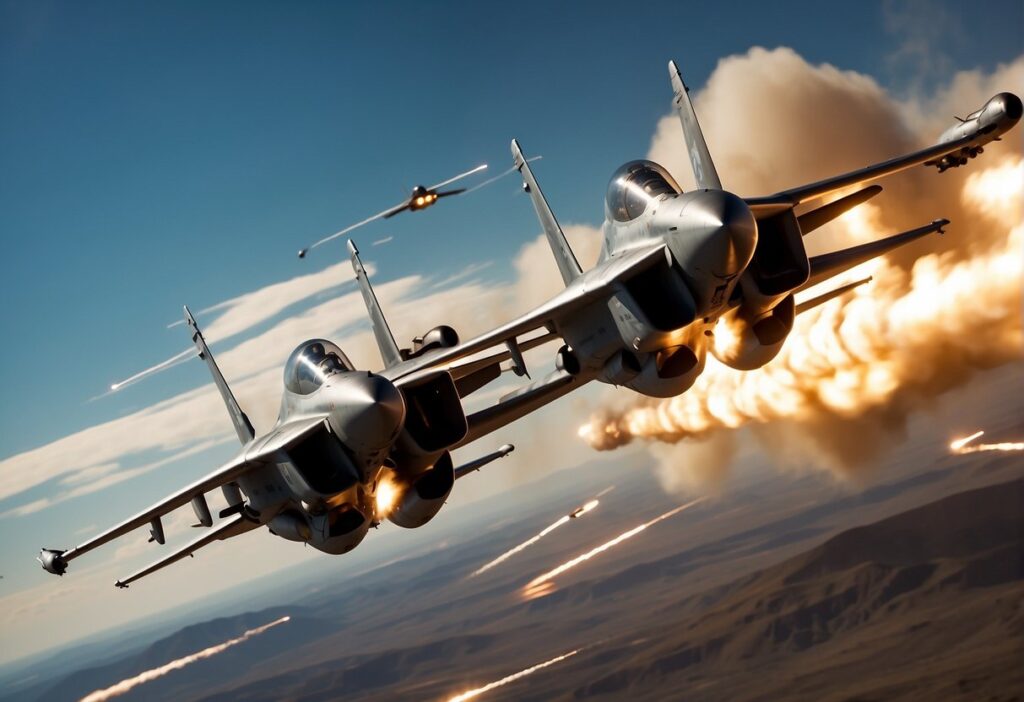The Dawn of Digital Top Guns
Welcome to the adrenaline-pumping world of aerial combat, where the roar of jet engines and the thrill of the chase have long been the hallmarks of the sky. But now, there’s a new player in the arena, one that’s shaking the very foundations of traditional dogfighting:
Artificial Intelligence. Strap in as we take you on a riveting ride through the clouds, where AI pilots challenge human supremacy in the ultimate test of aerial dominance.

The Sky’s New Rumble: AI vs. Human
The Thrilling Showdown
Picture this: a sun-kissed sky, two fighter jets hurtling toward each other, and the fate of air combat hanging in the balance. But there’s a twist—the pilot in one cockpit is flesh and blood, while the other? Pure silicon. Welcome to the world of AI dogfights.
The First Dance
In a historic aerial ballet, an F-16 fighter jet, guided solely by artificial intelligence, squared off against its human counterpart. The stakes? Not just victory, but the dawn of a new era in warfare. The X-62A VISTA (Variable In-flight Simulator Aircraft) took center stage, its digital brain calculating maneuvers with lightning precision.
The AI Ace Up Its Wingtip
Predicting the Unpredictable
Dogfighting—the ultimate test of skill, guts, and split-second decisions. For AI, it’s like mastering a wild stallion during a lightning storm. But guess what? The AI-operated VISTA aced it. It danced, spun, and dodged with eerie grace, leaving seasoned pilots slack-jawed. The secret? Machine learning, devouring data faster than a hungry hawk. It learned the art of combat, bending the rules without breaking a sweat.
Trust Issues and Ethical Skies
But can we trust AI at Mach speeds? That’s the million-dollar question. Safety protocols were baked in—no kamikaze stunts here. The VISTA played by the rules, respecting human norms for safe flight. It’s not just about winning; it’s about earning our trust.

Did you know that during the first live-fly dogfights between AI-flown jets and human pilots, the AI was trained not by studying pilot reports but by teaching itself through “billions” of simulations? This self-learning AI, loaded onto the X-62 VISTA, a highly modified F-16, demonstrated its prowess by safely executing complex maneuvers and strategies, showcasing the incredible potential of AI in modern aerial warfare. 🚀🤖
The Future Takes Flight
Wingmen of Tomorrow
Imagine a squadron of AI wingmen—unmanned, unyielding, and unafraid. Collaborative combat aircraft, they’re called. Picture them flanking human pilots, anticipating threats, and executing flawless maneuvers. The skies will never be the same.
Beyond the Horizon
AI dogfights are just the prologue. Soon, personalized drones will zip through clouds, defending borders, saving lives, and rewriting history. The X-62A VISTA? It’s the trailblazer, leaving vapor trails of progress.
Buckle Up, Sky Warriors
The Final Verdict
Who won the dogfight? The answer? It’s not about victory; it’s about evolution. AI isn’t here to replace us; it’s here to elevate us. So, buckle up, sky warriors. The silicon wings are spreading, and the future is soaring.
Key Trends and Developments
- Unmanned and Autonomous Systems: The increasing reliance on unmanned systems, such as drones and autonomous vehicles, is a major trend. These systems are being designed to carry out complex missions with minimal human intervention, enhancing operational efficiency and reducing risk to human soldiers. BAE Systems recently showcased a new high-performance stealth drone that underscores the focus on speed and covert operations in future conflicts (DroneXL.co). Additionally, the U.S. Navy is exploring the deployment of swarms of unmanned surface vessels (USVs) to enhance naval capabilities and distribute operational risks (National Defense Magazine).
- Artificial Intelligence and Automation: AI is set to play a pivotal role in future warfare. Advanced AI systems can process vast amounts of data to provide strategic advantages, such as identifying and targeting threats more effectively. However, these advancements also come with significant risks, such as the potential for autonomous systems to operate without human oversight, which necessitates stringent control measures (RAND).
- Multi-Domain Operations: The concept of Multi-Domain Operations (MDO) integrates military actions across all domains—land, sea, air, space, and cyberspace—synchronized with non-military activities to create strategic advantages. This approach aims to provide tailored options to influence adversaries’ behaviors while ensuring the security of allied populations (NATO ACT).
- Cognitive Warfare: NATO is developing the Cognitive Warfare Concept to address threats that target the mental and cognitive dimensions of military personnel and the public. This involves countering misinformation and psychological operations designed to undermine cohesion and trust within alliances (NATO ACT).
- Undersea Warfare Modernization: The U.S. Navy is advancing its undersea warfare capabilities through significant investments in automation, modernization of fire control systems, and the development of new torpedoes. This includes upgrading submarines with new hardware and software to ensure resilience and operational efficiency in future conflicts (Naval News).
Strategic Implications
The evolving nature of warfare means that future conflicts are likely to be multi-domain and involve a mix of manned and unmanned systems. The integration of AI and automation will be crucial in maintaining operational superiority. However, this also poses new challenges in terms of cybersecurity and the ethical use of autonomous systems. The emphasis on cognitive warfare highlights the importance of addressing not just physical but also psychological aspects of military strategy.
Conclusion: The Future of Aerial Mastery
As the dust settles on the battlefield of the skies, one thing is clear: the age of AI dogfights has only just begun. With every loop, roll, and dive, AI is rewriting the playbook of air combat, proving that the future belongs to those who embrace innovation.
Whether you’re a seasoned aviator or a curious onlooker, the message is the same—the sky is no longer the limit, it’s the beginning. So, keep your eyes on the horizon; the next chapter of aerial warfare is being written above the clouds, and it’s nothing short of extraordinary.